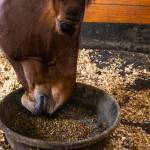Question
My fat horse is on to me. He sees the grazing muzzle slung over my shoulder as I make my trek to see him every morning, and he sashays away, motoring off in the opposite direction. We’ve been through all the games before: tempting him with feed, going out at other times of the day just to pet him, and binge-feeding his pasturemate with carrots and apple slices to lure him in. No dice. I can retrieve him without the muzzle in hand, but the evasive maneuvers he displays in his stall are even more creative and frustrating. Given this, can I just skip the muzzle and let him graze as he wants?
Answer
We feel your pain! Using a grazing muzzle is a great way to slow consumption of forage by horses that are predisposed to weight gain or obesity. But, as you describe so well, some horses become wise to the fact that the muzzle hampers intake. The risks of obesity and related problems, however, are too great to throw in the towel.
Without knowing the facilities available to you, it is difficult to recommend specific management guidelines. Because you mention a stall in your question, perhaps he can be stalled for a portion of the day and given mid-quality hay, fed in a slow-feed haynet. Mid-quality hay can be described as clean hay—free of dust and mold—that is of lower nutritional value than good- or high-quality hay. It might be a bit off-colored or the plants might be overly mature, for example. Horses are able to process forage like this without any problem, and the lower energy content keeps his calorie consumption in check. The use of a slow-feed haynet decreases rate of consumption considerably, drawing out the time it takes him to empty a haynet.
Aside from being stalled, do you have access to a drylot? The same scenario described above would work in a larger barren area. If a small, lush paddock is available, you can allow him and his pasturemate to graze down the paddock, and then keep the pair in that enclosure. You may find that the paddock produces enough grass to keep them eating but not so much that adds to their obesity. If grass becomes too scarce and you note they spend little time eating, you may augment the diet with mid-quality hay.
Depending on the horse’s age, soundness, and history, you could set up a reasonable exercise schedule for him, if he is currently not in work. Not only will exercise help him burn calories, but exercise is thought to keep some obesity-related issues, such as insulin resistance and metabolic syndrome, from getting an advantage. The goal should be at least 30 minutes of light to moderate exercise nearly every day, but more is acceptable. Exercise comes in many forms: structured arena work, longeing or free-longeing, trail rides, and swimming, just to name a few.
From a nutritional standpoint, horses that stay in at least moderate body condition on pasture generally do not need a concentrated source of energy. So, if your horse is consuming any kind of textured or pelleted feed, it would be wise to eliminate that from the diet, as it is only adding unnecessary calories. Horses do need a source of vitamins and minerals, though, and this usually comes in the form of a ration balancer or a well-fortified supplement that supplies nutrients for optimal health and well-being. One such supplement is Micro-Max, available in the U.S., or Gold Pellet, available to horse owners in Australia.








